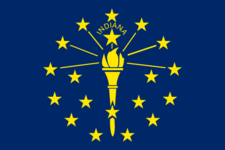Fact check: Did Indiana go from having a $2 billion surplus to a $1 billion deficit while John Gregg was Speaker of the House?
June 24, 2016
By Autumn Lewien
In one of the nation’s most closely watched campaigns for governor, John Gregg (D), a former state House Speaker, is trying to unseat first-term Indiana Gov. Mike Pence (R). It is a rematch from 2012 when [Pence beat Gregg by three percentage points.
In a campaign ad dated June 7, the Republican Governors Association's (RGA) Right Direction PAC claimed that "as Speaker of the Indiana House, Gregg helped turn a $2 billion surplus into a massive deficit."[1] On a website titled "The Real John Gregg," the PAC gave more detail on the phrase "massive deficit": "While John Gregg was Speaker of the House, Indiana went from having a $2 billion budget surplus to a budget deficit of close to $1 billion."[2]
We decided to take a closer look at that claim.
In 1998, about a year-and-a-half after Gregg was elected Speaker of the House, Indiana was sitting on a $2 billion "combined reserves" surplus. Four years later, according to a March 2002 Deficit Management Plan, the state was facing a projected $1.2 billion operating deficit by the end of the 2001-2002 fiscal year—Gregg’s last full fiscal year as Speaker. However, this comparison is misleading. The claim juxtaposes an actual reserve "surplus" with a projected deficit. Instead of ending fiscal year 2002 with a $1.2 billion deficit, the state recorded a $534 million reserve balance.
A $2 billion surplus?
Gregg took office as Speaker of the House in November 1996. His first budget (for the 1997-1999 biennium) took effect on July 1, 1997.[3]
After every budget cycle, the Indiana State Budget Agency publishes the amount of money held in its reserve funds. On June 30, 1998, the state's combined reserves totaled just over $2 billion.[4] Combined reserves, also called "total balances" or "unappropriated 'surplus' balance" in state reports, refer to the sum of the year-end balances in the General Fund, the Tuition Support Reserve, the Medicaid Reserve Account, and the Rainy Day Fund.[4][5]
The RGA PAC’s talk of a $2 billion surplus is, most likely, a reference to the 1998 figure.[6]
- See also: Glossary of state budget terms
A $1 billion deficit?
The state’s combined reserve balance fell by roughly $1.5 billion (from $2.01 billion to $534 million) between June 30, 1998 and June 30, 2002—Gregg retired from office in November 2002. (See Figure 1 and the chart below for reserve balances in past years.)[4]
| Breakdown of Indiana Reserve Fund Balances by Year (Millions of Dollars) | |||||||
|---|---|---|---|---|---|---|---|
| Fiscal Year | General Fund | Tuition Reserve | Rainy Day Fund | Medicaid Reserve* | Total Balances | Payment Delays | Total Net Balances** |
| 1996 | $1,024.8 | $215.0 | $439.5 | N/A | $1,679.3 | N/A | $1,679.3 |
| 1997 | $1,138.2 | $240.0 | $466.1 | N/A | $1,844.3 | N/A | $1,844.3 |
| 1998 | $1,319.3 | $240.0 | $496.1 | N/A | $2,055.4 | $0.0 | $2,055.4 |
| 1999 | $1,211.1 | $255.0 | $524.7 | N/A | $1,990.8 | $0.0 | $1,990.8 |
| 2000 | $832.6 | $265.0 | $539.9 | N/A | $1,637.5 | $0.0 | $1,637.5 |
| 2001 | $18.6 | $265.0 | $526.0 | $100.0 | $909.6 | $0.0 | $909.6 |
| 2002 | $0.0 | $265.0 | $269.2 | $0.0 | $534.2 | -$372.2 | $162.0 |
| 2003 | $136.6 | $305.0 | $278.5 | $0.0 | $720.1 | -$710.5 | $9.6 |
|
* "Medicaid Reserve was not included in combined balances and reserves prior to Fiscal Year 2001." | |||||||
While the decline in combined reserve balances is significant, it is not a $1 billion deficit. So, where does the $1 billion figure cited in the claim come from?[7]
In March 2002, the Indiana State Budget Agency released a Deficit Management Plan in which State Budget Director Betty Cockrum projected that the state would see an "annual operating deficit" of $1.2 billion by June 30, 2002, and a $1 billion deficit by the close of the 2001-2003 biennium.[8]
However, that figure was not an actual deficit. Indiana, like most states, has a constitutional provision requiring a balanced budget "in the sense that appropriations never exceed the sum of projected revenues plus existing balances," said Lawrence DeBoer, a state budget expert at Purdue University.[9][10]
"The state [C]onstitution is interpreted as requiring positive balances at the end of the fiscal year," stated DeBoer. "[A]nd in 2002 and 2003 the state used some 'fiscal gimmicks' to make that happen."[9]
Indeed, in 2002, the state legislature and governor implemented a series of short-term budget solutions, including payment delays, transfers from reserve accounts, and reversions, to balance the fiscal 2002 budget.[8][11] Additionally, in a 2002 special session, the state implemented a series of tax changes to offset the $1 billion deficit projected for the 2003 fiscal year.[12] The result: Indiana ended fiscal years 2002 and 2003 with total combined reserves of $534 million and $720 million, respectively.[4]
- See also: Indiana state budget and finances
Is Gregg to blame?
In the June 7 ad, the RGA PAC states that "as Speaker of the Indiana House, Gregg helped turn a $2 billion surplus into a massive deficit."[1]
While Indiana did not run an actual $1.2 billion deficit in fiscal 2002, the state's combined reserve balance did decline by 74 percent—from just over $2 billion to $534 million— during Gregg's tenure as Speaker. So the question becomes: What role did Gregg play in the $1.5 billion decline?
The Speaker of the House forges the state’s fiscal policy in concert with the governor and legislature. And, in the fiscal years 1999-2001, the executive and legislative branches did agree to deliberately spend down reserves, according to DeBoer.
"By fiscal [year] 1999 revenues had come in above forecasts for several years, balances were accumulating, and the governor and legislature were looking for tax cuts and added spending in order to reduce [the surplus]," said DeBoer. "Part of the reduction in balances was intentional, and the Republican controlled Senate went along."[9]
Indeed, during the 1999 general session, then-Governor Frank O'Brannon (D), the Democrat-controlled House, led by Gregg, and the GOP-run Senate adopted a budget that, through a series of tax cuts and one-time, targeted spending, reduced the state's combined reserves from $2 billion to a projected $1.2 billion at the end of fiscal 2001. (The actual combined reserve balance on June 30, 2001, was just under $910 million.)[13][14]
The actions were taken, however, "based on the assumption that the state would continue to experience normal revenue growth."[14] And just the opposite occurred. The 1990s technology boom was followed by a bust. Stocks started to fall in March 2000, and a recession ensued a year later.[15] During this time, Indiana failed to bring in as much money as it had planned—at the end of fiscal 2001, the state collected $721 million less in revenues than forecast in April 1999, and actual revenues reported at the end of the 2001-2002 fiscal year (June 30, 2002) were nearly $297 million short of November 2001 projections.[14][16] This drop in revenues, coupled with the tax cuts and one-time, targeted spending enacted during the 1999 legislative session, left Indiana to implement the fiscal gimmicks and tax reforms discussed in the section above to fill the projected $1.2 billion budget hole.[11]
Conclusion
The RGA Right Direction PAC claimed that "While John Gregg was Speaker of the House, Indiana went from having a $2 billion budget surplus to a budget deficit of close to $1 billion."[2]
In 1998, about a year-and-a-half after Gregg was elected Speaker of the House, Indiana was sitting on a $2 billion "combined reserves" surplus. Four years later, according to a March 2002 report, the state was facing a projected $1.2 billion operating deficit for the fiscal year ending June 2002—Gregg’s last full fiscal year as Speaker.
However, this comparison leaves out important information. The $1.2 billion figure was not an actual deficit. Indeed, in 2002, the state implemented a series of short-term budget solutions and tax changes to balance the fiscal 2002 budget. The result: Indiana ended the 2001-2002 fiscal year with a $534 million combined reserve balance—a $1.5 billion (74 percent) decline from 1998, but still a surplus.
See also
Launched in October 2015 and active through October 2018, Fact Check by Ballotpedia examined claims made by elected officials, political appointees, and political candidates at the federal, state, and local levels. We evaluated claims made by politicians of all backgrounds and affiliations, subjecting them to the same objective and neutral examination process. As of 2025, Ballotpedia staff periodically review these articles to revaluate and reaffirm our conclusions. Please email us with questions, comments, or concerns about these articles. To learn more about fact-checking, click here.
Sources and Notes
- ↑ 1.0 1.1 YouTube, "RGA Indiana Ad: 'Facts,'" June 6, 2016
- ↑ 2.0 2.1 The Real John Gregg, "From a Surplus to a Deficit," accessed June 12, 2016
- ↑ Autumn Lewien "Email conversation with Jeff Harris," June 22, 2016
- ↑ 4.0 4.1 4.2 4.3 Indiana State Budget Agency, "A History of State Operating Revenue and Reserve Fund Balances Compared to the Operating Revenue Stream," accessed June 13, 2016
- ↑ Indiana Office of the Auditor of State, Comprehensive Annual Financial Report for the Fiscal Year Ended June 30, 2002," accessed June 20, 2016
- ↑ Jon Thompson, Republican Governors Association's communication director, in an email conversation with Autumn Lewien dated June 14, 2016, provided us with the following quote: "The $2 Billion general fund surplus that existed one and one-half years ago is decreasing." Thompson cited the source of the quote as a December 31, 2001, Auditor's Report issued by Connie N. Nass. However, we were unable to find the original source. We reached out to the campaign to confirm this $1.2 billion combined reserves figure but have not yet received a response. If we do, we will update the article accordingly.
- ↑ Jon Thompson, Republican Governors Association’s communications director, pointed Ballotpedia to two Indianapolis Star articles, both of which cite the $1 billion figure. The two articles cited by the RGA are: Indianapolis Star, "Gov. O’Bannon Defends Indiana’s credit rating," December 5, 2001, and Indianapolis Star, "Legislative Perk is a crying Shame," April 1, 2003. Both articles are located behind a paywall.
- ↑ 8.0 8.1 Indiana State Budget Agency, "Deficit Management Plan: A Plan for Managing the State Budget through June 30, 2003 and Beyond," March 28, 2002
- ↑ 9.0 9.1 9.2 Autumn Lewien, "Email conversation with Lawrence DeBoer," June 17, 2016
- ↑ National Conference of State Legislatures, "State Constitutional and Statutory Requirements for Balanced Budgets," accessed June 18, 2016
- ↑ 11.0 11.1 National Association of State Budget Officers, "The Fiscal Survey of States," November 2002
- ↑ Indiana Legislative Services Agency, "Fiscal Impact Statement: HB 1001 (SS)," June 21, 2002
- ↑ The one-time, targeted spending included: $290M to reduce future teachers’ retirement fund liabilities; $200M for local road construction; $155M in state infrastructure investments; $80M for new university buildings; and $82M for university technology investment.
- ↑ 14.0 14.1 14.2 Indiana State Budget Agency "The O’Bannon-Kernan Balanced Budget Plan," November 15, 2001
- ↑ The National Bureau of Economic Research, "The Business-Cycle Peak of March 2001," November 26, 2001
- ↑ Indiana State Budget Agency, "General Fund and Property Tax Replacement Fund: FY 2002 Report of Monthly Revenue Collections, Targets per November 14, 2001 Forecast," accessed June 20, 2016
Contact
More from Fact Check by Ballotpedia
| Did an Indiana gay rights bill include religious freedom protections? May 2, 2016 |
| Fact-checking Mike Pence on Indiana business rankings February 15, 2016 |
| Voter turnout rates in Indiana November 6, 2015 |
Follow us on Facebook and Twitter










